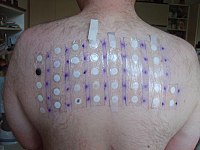
Photo from wikipedia
BACKGROUND Despite being widely used in different areas of dermatology, there have been few studies evaluating the benefit of dermoscopy in the interpretation of patch tests, especially in weak and… Click to show full abstract
BACKGROUND Despite being widely used in different areas of dermatology, there have been few studies evaluating the benefit of dermoscopy in the interpretation of patch tests, especially in weak and doubtful reactions. OBJECTIVES To evaluate the role of dermoscopy in the interpretation of patch tests and describe the main findings of the reactions. METHOD Prospective study, carried out in dermatology reference centers in southern Brazil, which evaluated the final results of patch tests analyzed with the aid of dermoscopy. RESULTS 77 patients and 160 reactions were included. The most prevalent substances were nickel sulphate (23.8%), kathon CG (9.4%), and perfume mix (8.8%). The main dermoscopic findings were reaction area greater than half of the chamber site (90%), homogeneous erythema (86.9%), vesicles (30%), crusts (21.3%), perifollicular erythema (35%), pore reaction (19.4%) and pustules (8.8%). Dermoscopy was found to facilitate the definition of erythema in reactions on black skin and when due to substances with deposition of pigment. Of the 64 weak or doubtful reactions, 36 (56.25%) showed a change in the final result after dermoscopy evaluation; of the 36 doubtful reactions, 33 (91.6%) showed a change in the final result after dermoscopy evaluation (p < 0.001). STUDY LIMITATIONS The probable limitation of the study is its sample size. Though certain significance levels have been reached, other possible relationships may not have been observed. CONCLUSION Dermoscopy improves significantly the interpretation of patch tests, especially in weak and doubtful reactions.
Journal Title: Anais brasileiros de dermatologia
Year Published: 2021
Link to full text (if available)
Share on Social Media: Sign Up to like & get
recommendations!